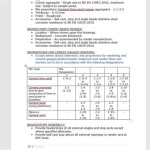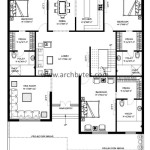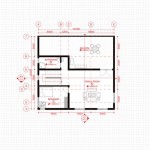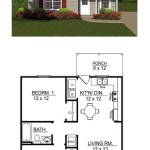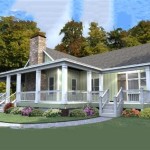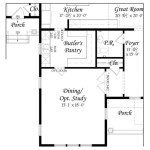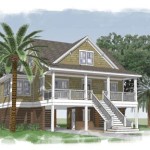One Bedroom Apartment Floor Plan With Dimensions: A Detailed Guide
The one-bedroom apartment floor plan is a popular choice for individuals, couples, and even small families seeking a compact and manageable living space. Understanding the dimensions of such a plan is crucial for effective furniture placement, space optimization, and overall comfortable living. This article provides a comprehensive overview of one-bedroom apartment floor plans, emphasizing the significance of dimensions and offering insights into various layouts.
A standard one-bedroom apartment typically ranges from 600 to 900 square feet, although this can vary depending on location, building type, and design. The floor plan generally includes a living area, a bedroom, a kitchen, a bathroom, and often a designated dining area or flex space. Knowing the precise dimensions of each area is paramount for planning furniture arrangements, determining storage solutions, and ensuring that the space meets individual needs and preferences.
Before delving into specific dimensions, it is essential to understand the architectural conventions used in floor plans. Dimensions are usually indicated in feet and inches, often marked with a single quote (') for feet and a double quote (") for inches. For instance, 12'6" signifies 12 feet and 6 inches. It is also important to note the thickness of walls, which can impact the usable space within a room. Interior dimensions are typically measured from the interior faces of the walls.
Understanding Key Areas and Their Dimensions
Each area within a one-bedroom apartment serves a distinct purpose, and their dimensions are critical for functionality and comfort. A well-designed floor plan optimizes the use of space in each area, ensuring that it meets the residents’ lifestyle requirements.
Living Area: The living area is the primary space for relaxation, entertainment, and social interaction. The dimensions of this area greatly impact the type and size of furniture that can be accommodated. A living area typically ranges from 150 to 250 square feet. For instance, a living area measuring 12' x 15' provides 180 square feet of space. This allows for a standard-sized sofa (approximately 7-8 feet in length), a coffee table, an entertainment center, and potentially a small armchair or side table. Larger living areas, such as those measuring 15' x 18' (270 square feet), can accommodate larger furniture pieces, such as sectional sofas, and provide ample space for movement.
Bedroom: The bedroom is a private sanctuary for rest and sleep. A crucial dimension to consider is the space required for the bed itself. A queen-size bed, which is a common choice for one-bedroom apartments, measures approximately 5' x 6'8" (60" x 80"). Therefore, the bedroom should ideally be at least 10' x 10' to comfortably accommodate the bed and allow for walking space around it. A bedroom measuring 12' x 12' provides more space for additional furniture, such as dressers, nightstands, and a reading chair. The placement of windows and closets also influences the optimal layout of the bedroom.
Kitchen: The kitchen is a functional space for preparing meals and storing food. In a one-bedroom apartment, the kitchen is typically compact, often integrated with the living area or occupying a small, separate space. The layout and dimensions of the kitchen dictate the efficiency and ergonomics of the cooking area. A typical one-wall kitchen layout might span 8' to 10' in length and include a refrigerator, stove, sink, and cabinets. L-shaped or U-shaped kitchens provide more counter space and storage. The dimensions of these layouts vary depending on the available space, but a minimum width of 6' is generally required for comfortable movement. Island kitchens are less common in one-bedroom apartments due to space constraints, but if present, they usually measure around 3' x 6' to provide additional prep space and storage.
Bathroom: The bathroom is a relatively small but essential space for personal hygiene. A standard one-bedroom apartment bathroom typically measures around 5' x 8' (40 square feet). This space usually includes a toilet, a sink, and a shower or bathtub. Larger bathrooms may feature separate shower and tub areas, as well as additional storage. The dimensions of the shower or bathtub enclosure are crucial for comfort and functionality. A standard bathtub measures approximately 5' in length and 30" in width. Shower stalls often measure 3' x 3' or 4' x 4'.
Dining Area/Flex Space: Many one-bedroom apartments include a designated dining area or a flexible space that can be used as a dining area, home office, or additional living space. The dimensions of this area vary depending on the overall floor plan and design. A dining area typically requires at least 8' x 8' of space to comfortably accommodate a dining table and chairs for two to four people. Flex spaces can range in size from 6' x 8' to 10' x 10', depending on their intended use.
Analyzing Different One-Bedroom Apartment Layouts
One-bedroom apartment floor plans come in various layouts, each with its own advantages and disadvantages. Understanding these layouts and their associated dimensions is crucial for selecting a plan that best suits individual needs and preferences.
Linear Layout (Railroad Style): In a linear layout, the rooms are arranged in a straight line, often with the entrance leading directly into the living area. This layout is common in older buildings and can present challenges in terms of privacy and natural light. The dimensions of each room are crucial in maximizing the limited space. For instance, a living area measuring 12' x 12' might be sufficient, but the bedroom size becomes even more critical to ensure privacy from the living space. The kitchen is often located at the end of the line, sometimes separated by a small partition or counter.
Open Concept Layout: The open concept layout is popular in modern apartments and features a combined living area, dining area, and kitchen. This layout promotes a sense of spaciousness and allows for greater flexibility in furniture arrangement. However, it can also be challenging to define distinct zones within the open space. Careful consideration of dimensions is essential to create functional and aesthetically pleasing divisions. For example, strategically placed furniture, such as a large sofa or bookshelf, can help delineate the living area from the dining area. The kitchen often features an island or peninsula that serves as a countertop and a subtle divider.
L-Shaped Layout: An L-shaped layout features the living area and kitchen arranged in an 'L' formation, with the bedroom and bathroom located off a hallway. This layout provides a good balance between openness and privacy. The dimensions of each area are important for ensuring that the space feels comfortable and functional. The living area and kitchen can be designed as an open concept space, while the bedroom is tucked away for privacy. The hallway leading to the bedroom can also be used for additional storage.
Utilizing Dimensions for Space Optimization
Understanding the dimensions of a one-bedroom apartment floor plan is only the first step. The next crucial step is to utilize these dimensions to optimize the use of space and create a comfortable and functional living environment.
Furniture Selection: Choosing the right size and type of furniture is paramount for maximizing space. Oversized furniture can overwhelm a small apartment, making it feel cramped and cluttered. Conversely, furniture that is too small can look out of place and fail to provide adequate seating or storage. Before purchasing furniture, it is essential to measure the available space and carefully consider the dimensions of each piece. Opt for furniture that is appropriately scaled to the size of the room and that serves multiple purposes. For instance, a sofa bed can provide additional sleeping space for guests, while a coffee table with built-in storage can help keep the living area tidy.
Layout Planning: A well-planned layout can significantly improve the functionality and flow of a one-bedroom apartment. Experiment with different furniture arrangements on paper or using online design tools before physically moving furniture. Consider the natural flow of traffic and ensure that there is adequate space for movement. Arrange furniture to create distinct zones for different activities, such as relaxing, dining, and working. Avoid blocking windows or doorways, and maximize the use of natural light.
Storage Solutions: Storage is often a challenge in one-bedroom apartments. Maximize vertical space by utilizing tall bookshelves, cabinets, and wall-mounted shelves. Under-bed storage containers can provide additional space for storing clothes, linens, and other items. Choose furniture with built-in storage, such as ottomans with lift-up lids or coffee tables with drawers. Utilize closet organizers to maximize the storage capacity of closets. Consider adding floating shelves to the walls for decorative items and small storage.
Visual Tricks: Even if the physical space is limited, there are several visual tricks that can make a one-bedroom apartment feel larger and more spacious. Use light colors on walls and furniture to create a sense of airiness. Mirrors can reflect light and create the illusion of more space. Avoid clutter and keep surfaces clean and organized. Use vertical stripes on walls or curtains to visually elongate the room. Choose furniture with clean lines and minimal ornamentation.
By carefully considering the dimensions of a one-bedroom apartment floor plan and implementing strategic space optimization techniques, it is possible to create a comfortable, functional, and aesthetically pleasing living environment that meets individual needs and preferences.

Apartment Floor Plans Vantage On The Park

1 Bedroom Apartment Plan Examples

One Bedroom Apartment Floor Plans Ovation 309

One Bedroom Apartment Floor Plans Ovation 309

Floorplan Of One Bedroom Apartment Used As Acoustic Environment For The Scientific Diagram

1 Bedroom Apartment Plan Examples

Pin Page

One Bedroom Style F Waterfront Apartments

Pin Page

One Bedroom Standard Floor Plan Apartments In M Massachusetts Princeton Crossing
Related Posts

